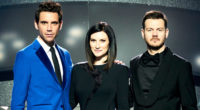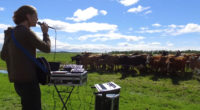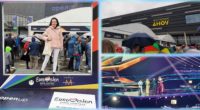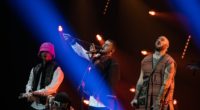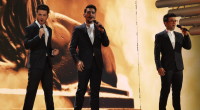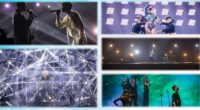
And so we find ourselves Mid Atlantic once again, in Reykjavík at the RÚV headquarters, Útvarpshúsið to be more precise to cheer on the final five in this the last Icelandic semi. There are two groups in contention tonight; will their combined sounds prove too powerful a match for the three female vocalists?
Hostesses Ragnhildur Steinunn Jónsdóttir and Guðrún Dís Emilsdóttir welcomed us back to the studio to inspect the final five contenders in the running for not only the honour of representing Iceland in Copenhagen this May, but also to be rewarded very handsomely financially with a prize of ISK 1,000,000 at stake.
Gúðrun Árny is back once again following her appearance at the 2012 selections with Minningar. She also tried in 2006 with Andvaka, so hopefully the third time will work a charm. Will she face competition from the Icelandic/Swedish team that have entered Aðeins ætluð þér into this year’s selection or from the boyish charm of the group F.U.N.K or the not so boyish charm, but charming nevertheless Pollapönk? It’s anybody’s guess, but we won’t have to wait long before we get to meet and congratulate the newest two finalists.
The songs: (To read more about the five participants check out our Get To Know article)
1. Sigríður Eyrún Friðriksdóttir – Lífið kviknar á ný (Life awakens once more) (T: Sigríður Eyrún Friðriksdóttir / M: Karl Olgeir Olgeirsson)
Lífið kviknar á ný is the perfect opener for the second semi final; swinging, playful, full of sass and with a definite Motown vibe over it. The instrumentation does however hark back to the 30’s in some way with echoes of doowop about it. Sigga Eyrún sings like a femme fatale, even though the message of the song is about not giving up and knowing that you can do anything you want. It even contains that all important key change which should keep many happy. The stage was bathed in oranges and peach hues, with Sigga Eyrun glittering in a diamanté encrusted creation paired with a flowing chiffon cape in matchnig peack tones. She had two female dancers wearing feathered headresses and tassled dresses and three female backing singers in similar garb. The dancers writhed and shimmied in front of what looked like a radiator, before they continued their way around the stage with Sigga Eyrun; there was some great interaction there and some fantastic camera close ups of Sigga Eyrun with the wind machine blowing through her hair. Vocally she was very comfortable for most of the song, but the vocals veered over to screeching towards the end. A fun and light hearted start to the first heat.
2. Guðrún Árný Karlsdóttir – Til þín (For You) (T:Guðrún Eva Mínervudóttir/ M: Trausti Bjarnason)
Time for the only ballad of the evening, the mournful and tender Til Þín. A hauntingly beautiful and fragile melody where Guðrún Árný’s voice is perfectly complemented by the male backing vocals. Towards the middle of the song, the mood intensifies as the song builds towards a key change with vocals becoming much stronger – a definitive gossebump moment. The lyrics are extremely moving, dealing with a mother having to leave her child, the tears and cries of said child remaining in her memory, but she promises to return. The stage was set with dramatic reds and blacks. Guðrún Árny was joined by four male singers sharply turned out in black suits. She didn’t let the side down either with a long flowing beige dress and a black, intricate lacy sleeveless top. Guðrún Árny was in fine voice, belting out the notes; her vocal prestation was pitch perfect; just like the studio version and the blending of her voice with that of her backing singers was just as breathtaking live. Hers was a very intense, if slightly static stage show, with little action going on stage, but it would have looked strange with anything else. The music here will ust have to speak for itself.
3. F.U.N.K. – Þangað til ég dey (Until I die) (T & M: Pétur Finnbogason / Franz Ploder Ottósson / Lárus Örn Arnarson)
With plenty of groove and a hefty bassline underpinning the intro to Þangað til ég dey, we can practically taste the promise of funk a plenty with a definite Dobbie Brothers influence. Not as dance friendly as Stattu Upp! from 2012, as the song changes tempo underway. That’s not neccessarily a bad thing, as this entry is far more adult, with a slighty darker edge to it; an interesting musical composition with a touch of briliance in the early 80s synth. The stage backdrop for funk was again a mixture of red and black prisms, with a sky blue floor .They were alll dressed in suit jackets of blue and reds and black trousers. Two of the members were on guitar, one on drums, one on keyboards and one on vocals. F.U.N.K. had some rather stiff dance moves – they failed to come alive like the explosion we witnessed two years ago with Blár Ópal, but the vocals were faultless. There was a cool, funky vibe, but sadly it didn’t feel as alive as the studio version. Sounds odd to say that, but it just came across as rather subdued in comparison.
4. Guðbjörg Magnúsdóttir – Aðeins ætluð þér (Only for you) (T & M: María Björk Sverrisdóttir / Marcus Frenell / Johnny Sanchez / Beatrice Eriksson)
The steel guitar intro takes us into country and western territory with Aðeins ætluð þér, a song about having loved somebody and everything that entails only to see everything go belly up and having only memories to remember. It is an uptempo number with a radio friendly sound, but not one of María Björk’s stronger efforts. The stage was dark with only the floor lit up, Guðbjörg’s four female backing singers dressed in black, standing with their backs to her. She was wearing a dress that was not easy on the eye – it was brown and orange and resembled a kind of native American Indian pattern. Her vocals were questionable – she bombed out completely on the first note, which kind of set the pace for the rest of the number; no matter how much arm raising and beckoning her backing singers did, they couldn’t save this. This has the most key changes of the evening, but at one point Guðbjörg was practically blown away by an out of control wind machine. An average number, semi filler, but nothing more.
5. Pollapönk – Enga fordóma (No prejudices) (T & M: Arnar Gíslason / Guðni Finnsson / Haraldur F. Gíslason / Heiðar Arnar Kristjánsson)
The final act of the evening is the quartet Pollapönk with their rather noisy Enga Fordóma. The song that deals with prejudices and stigma faced by outcasts in society, reflected in the stuttered parts – who knew speech impediments could be so rhythmic? This has a brash, almost punkish sound intertwined with a definite feel of Americana, complete with jangly guitars. Funky bass guitars appear before the song launches into the penultimate chorus and a key change. The four took to the stage in tracksuits in blue, red, pink and yellow, looking like four men in the middle of a mid life crisis. Three were on guitars, one on drums. Their backdrop was black and green, pierced by white rays. It was an amateurish performance; far from as polished as some that we have seen tonight, but just as charming if not so more. The vocals were shouted, they were nothing to write home about. They were having a whale of a time on stage – shame the rest of us weren’t.
The show:
Hostesses Ragnhildur Steinunn Jónsdóttir and Guðrún Dís Emilsdóttir looked very glam indeed on the small stage, wearing predominantly black; Guðrún with a black feather neckpiece over a beige top and a black leather skirt, Ragnhildur in a simple, elegant black little number. After the second number, we were treated to blooper clips showing what goes on behind the scenes leading up to the semi final with some light hearted interviews with the artists. After the final number, we were taken backstage and treated to short interviews with all of the contestants tonight. Guðrún Árný revealed that she was just as nervous, regardless of how many times she’s taken part previously – she couldn’t stand still, hopping from one foot to another. Two of the members of Pollapönk were able to say that they had been in touch with a John Grant when asked if they would perform their entry in English if they were to win, so we’re guessing the answer is yes.
The voting:
Lines were opened as soon as the last number had been performed. We were also informed that we would not only find out which two acts had been voted to the final by the public, but also the two that the jury had decided to award spots to, completing the six strong line up. Pollapönk and F.U.N.K. were the acts that received the trust of the televoters, getting two spots in the final. Show opener Sigga Eyrun bagged the first of the jury wildcards while the other went to the final by help of the jury wilcard was Ásdís María Viðarsdóttir with Amor.
Iceland at the Eurovision Song Contest:
The small nation of Iceland was the last of the Nordics to make its debut in 1986 with the imaginatively named trio ICY and the entry Gleðibankinn (Bank of fun), finishing 16th. Icelanders have embraced the contest wholeheartedly and the first few years of their participation became practically a national obsession. Often finishing mid field, Iceland has however sent some noteable entries – in 1990, they had their first real taste of success ending fourth with the bouncy Eitt Lag Enn (One More Song) by Stjórnin. Artist Sigga Beinteinsdóttir has gone on to represent Iceland two more times – in 1992 as part of Heart 2 Heart, finishing a respectable 7th place with the infuriatingly catchy Nei eða já and in 1994 with the much acclaimed ballad Nætur, coming in 12th. They have come tantalisingly close to winning the gold medal on two occasions – in 1999, when Selma and All Out of Luck was pipped at the post and ten years later, in 2009 with Jóhanna and her mournful balad Is It True?. This year will be their 27th participation at the contest.






